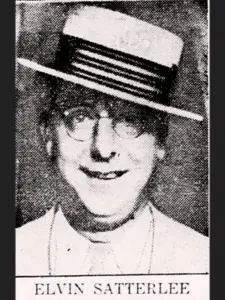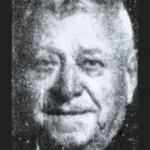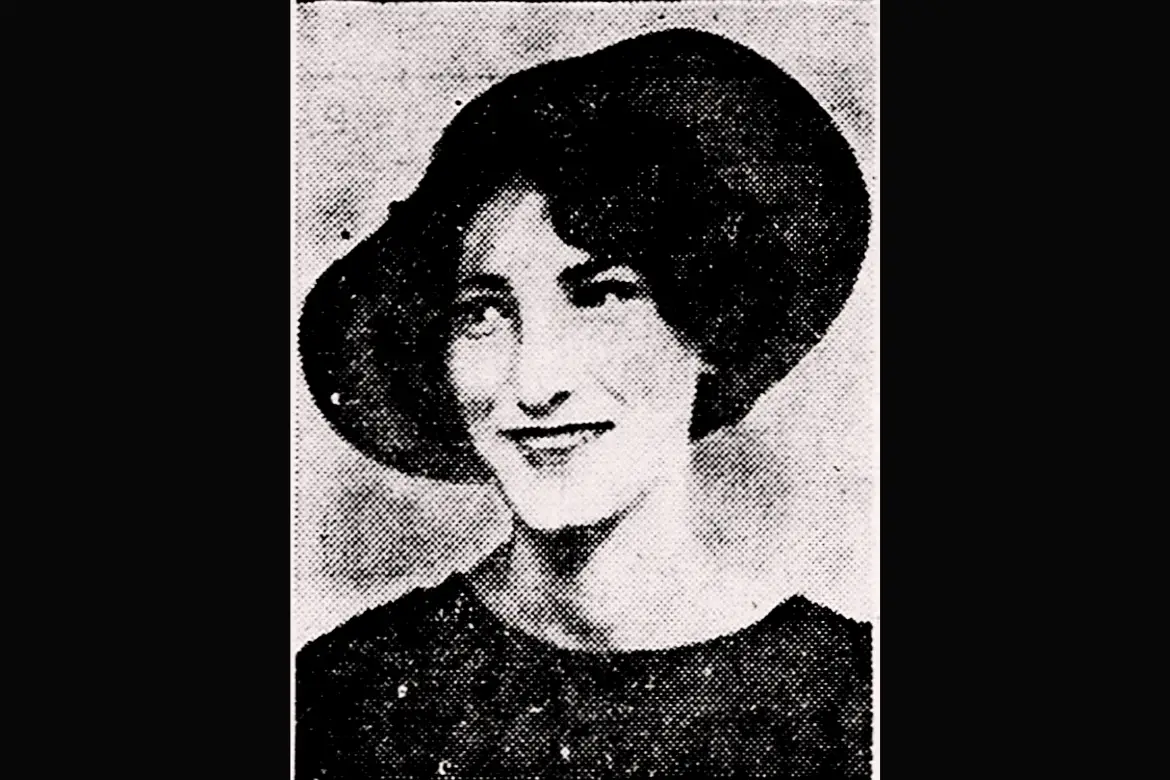Mary Francis Britton was born in Champaign County, Illinois, on August 27, 1906, to Harvey and Mildred Estelle “Estella” Britton. She was one of eight children and the third youngest.
Mary was married at some point. Reports vary; some say she was divorced, while others say she was a widow. Her husband’s name is unknown.
Around 1935, Mary began an affair with a married man named Thomas Elvin Satterlee. Satterlee was born in Irving, Illinois, on May 11, 1903, to Arthur Ernest Satterlee and Katherine Elizabeth Satterlee.
Satterlee was previously married to Eliza Ann Farmer, and they tied the knot on September 9, 1924. She died on December 28, 1925, at age 23.
Satterlee married Katherine Fenton on May 7, 1927. Newspaper articles from 1938 reported that Satterlee was the father of one child, which would have been his daughter Jean Louise Satterlee, born in 1928. He was a prominent businessman who owned an automobile dealership in Centralia, Illinois, about 65 miles east of St. Louis. He had been paying for Mary to attend beauty school in East St. Louis. But soon tragedy would strike, and a ridiculous death ruling would close the case forever.
The Death of Mary Francis Britton

In 1938, Satterlee, then 35, rented or purchased (reports vary) a home in Centralia. Mary, 31, arrived for a visit on July 4, 1938, with plans to stay for several days.
Around 1 p.m. on July 7, 1938, Satterlee and his friend Arthur Donie traveled to St. Louis on a business trip. They arrived back at Satterlee’s home at 6 p.m. and found Mary dead on the floor in the upstairs bedroom.
Police arrived at a perplexing scene. As officers made their way to the bedroom, they found bloodstains on a coffee pot in the kitchen and the walls of the stairway leading to the second level. According to newspaper articles, “The upholstery on several chairs had been ripped to shreds and the glass in a china closet and a floor lamp had been broken.”
Mary was nearly nude and had been shot in the heart. Dr. E.N. Neber, who examined the body, stated Mary also had a deep scratch or cut on her right hand. Some reports also said that she had other cuts and bruises on her body.
Crumbled underneath Mary’s body was a note that read in part:
“I have lived with you as man and wife for three years… I love you and you have fallen in love with someone else. Love, Mary.”
It was a strange note, to say the least, as they were not living together. But because of that note, police immediately said Mary’s death looked like a suicide, even though Mary did not mention taking her own life.
Strangely, police located the revolver used in the shooting on the blood-soaked bed. The gun had been fired twice, but the police found only one bullet – the one that exited Mary’s heart and landed in a pillow.
Dr. Neber told the police that Mary’s death was instantaneous.
Police Chief William Kaelin said on July 8, 1938: “Therefore, we do not believe Miss Britton could have caused the bloodstains around the house. Another thing, a woman visiting next door reported that she had heard cries for help in the Satterlee home yesterday afternoon.”
One neighbor reported seeing a blonde woman, later identified as Beulah Britton, 20, Mary’s younger sister, arriving at Satterlee’s home at 5 p.m. on July 7, one hour before Satterlee and Donie found Mary’s body. The neighbor said the woman left the house, walked to the curb, and entered a car driven by a man. The couple then drove away. The neighbor did not know if Beulah Britton had entered the residence, or knocked on the door and left when no one answered.
Unbelievable Ruling
A coroner’s jury met on Saturday, July 9, 1938. Despite the overwhelming evidence of murder, the jury found Mary had died from a self-inflicted gunshot wound. In other words, she killed herself.
Three witnesses testified at the hearing, including Satterlee, who stated that jealousy was a possible motive. However, he had earlier told the police that Mary was the only other woman he was seeing outside of his marriage.
Mary’s friend, R.S. Welman of Sandoval, testified that Mary seemed “upset with jealousy” shortly before her death. She had told him she would be “better off dead” and was “tired of it all.”
The third witness, Al Westman, a mechanic at Satterlee’s dealership, claimed he had overheard Mary threaten to kill herself.
To make matters in this hearing worse, Coroner S. D. Carrigan gave BS testimony that he believed Mary “tore up the house in a rage and then shot herself.”
However, not one person explained why Mary was almost naked, the gun lay on the BED, and her body was on the FLOOR. Or that someone had fired the weapon TWICE, and one bullet was missing.

After the ridiculous verdict from the jury, police closed the case, and that was the end of that. Mary never received the justice she deserved.
Satterlee married four times and twice after Mary’s death. He had three daughters and one son. They are now deceased. By 1952, Satterlee lived in Tempe, Arizona. He married his fourth wife, Mary Christine Campbell, 26 years his junior, on December 30, 1952. Mary was younger than one of Satterlee’s daughters. She and Satterlee later resided in Mesa, where he died at age 90 in 1994. Mary died in 2005.
TCD’s Thoughts
The following is strictly the opinion of this author.
I accidentally discovered Mary’s case while looking up another and am astounded that authorities ruled her death a suicide when someone clearly murdered her.
I believe Satterlee and Donie arrived at Satterlee’s residence earlier than 6 p.m. or never went to St Louis. Satterlee possibly killed Mary because she might have demanded that he leave his wife, and Satterlee was not willing to do that. There is also the possibility that Satterlee’s wife, Katherine, killed her out of jealousy.
The killer left behind so much evidence, and the police willingly ignored it.
- Mary was almost nude, and it doesn’t appear Dr. Neber checked for a sexual assault, even though she had apparent signs of an attack on her body.
- The gun was on the blood-soaked bed while Mary’s body was on the floor. It’s evident to me that Mary was killed ON THE BED. How did she end up on the floor? If she had taken her own life, the gun would have been near her body.
- The missing bullet nobody seemed to worry about.
- Police found quite a bit of blood in various places around the home. The jury seemed to forget this, among other things.
- The “suicide note” was crumpled under her body. If you were going to take your own life, you would not crumple it up, as if you’re throwing it away, and place it underneath you.
Satterlee was a prominent businessman in Centralia, so I do not doubt that his position influenced the final ruling in Mary’s death.
I also believe that he paid his mechanic to lie on the stand.
Just because Mary might have said to her friend that she was “better off dead” and “tired of it all” does not mean she planned to take her own life. Hell, I have said both, and I am still here.
I bet they didn’t compare Mary’s handwriting to the note. Maybe they didn’t do that back then, I don’t know, but I bet they would have found she never wrote it if they had.
Sources
Associated Press. “Jurors Return Suicide Verdict in Girl’s Death.” The Decatur Daily Review, July 9, 1938.
“Conduct Probe Woman’s Death At Centralia.” The Taylorville Daily Breeze Courier, July 8, 1938.
“Mary Francis Britton.” Online Memorial. FindAGrave.com. https://www.findagrave.com/memorial/228010446/mary_francis_britton
“Officers Puzzled by Widow’s Death in Centralia Home.” The Oshkosh Northwestern, July 8, 1938.
United Press. “Hunt Blonde in Death of Widow.” The Knoxville News-Sentinel, July 8, 1938.
Other source: FamilySearch.org.



